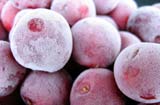Freezing Fruit
Stretch Summer Out
- Introduction
- Selecting Freezer Containers
- Preparing the Fruit
- Types of Packs
- Packaging, Labeling, and Storing
Introduction
Freezing is one of the easiest, most convenient, and least time-consuming ways to prepare foods at home. Freezing does not sterilize food, but the extreme cold slows growth of microorganisms and changes that affect quality or cause spoilage in food. Properly frozen fruits will retain much of their fresh flavor and nutritive value. Their texture, however, may be somewhat softer than that of fresh fruit.
Selecting Freezer Containers
Before preparing fruit for freezing, assemble the containers you will use. Containers should be moisture-vapor resistant, durable, and easy to seal, and should not become brittle at low temperatures.
Containers suitable for freezing fruits include plastic freezer containers, flexible freezer bags, or glass jars. If jars are used, be sure to use wide-mouth jars for fruits packed in liquid. Regular (narrow-mouth) jars break too easily at the neck.
Some household containers are not recommended for freezing. The cardboard cartons that milk, ice cream, and cottage cheese come in are not moisture-vapor resistant enough. Regular (not canning) jars break too easily at freezer temperatures.
Preparing the Fruit
Sort, wash, and drain fruits carefully, discarding parts that are green or of poor quality. Do not allow fruit to soak in wash water or it will lose nutrients and flavor. Prepare fruits as they will be used--stemmed, pitted, or sliced. Prepare enough fruit for only a few containers at a time, especially those fruits that darken rapidly.
Do not use galvanized equipment in direct contact with fruit. The acid in the fruit dissolves zinc, which can be harmful in large amounts. Also, be wary of using iron utensils or chipped enamelware, as metallic flavors can result.
Types of Packs
There are several ways to pack fruits for freezing: syrup pack, sugar pack, dry pack or unsweetened pack.
Most fruits have a better texture and flavor if packed in sugar or syrup. However, the sugar is not necessary to safely preserve the fruit. For those watching their sugar intake, it can be left out or an artificial sweetener can be substituted.
The type of pack will depend on the intended use. Fruits packed in syrup are generally best for uncooked dessert use. Those packed in dry sugar or unsweetened are best for most cooking purposes, because there is less liquid in the product. Whichever method you choose, be sure to leave enough space at the top.
Packaging, Labeling, and Storing
Most foods require headspace between the packed food and closure. This allows for expansion of the food as it freezes.
Before closing freezer containers, make sure sealing edges are free of moisture and food particles. Seal the container and label plainly. Include name of food, date and type of pack.
Freeze packaged fruits as quickly as possible at 0°F or below. For quickest freezing, place packages against the refrigerated surfaces of the freezer. Freeze no more food at one time than will freeze within twenty-four hours--usually two to three pounds of fruit per cubic foot of freezer space. After fruit is frozen, rearrange the packages and store close together.
Most fruits maintain high quality for eight to twelve months at 0°F or below; citrus fruits and citrus juices for four to six months. Unsweetened fruits lose quality faster than those packed in sugar or syrup. Longer storage will not make the food unfit for use, but may impair its quality. It is a good idea to post a list of the frozen foods with freezing dates near the freezer and check the packages off the list as they are removed.
Excerpted and adapted from:
Preserving Food: Freezing Fruits (FCS 8767) by Judy A. Harrison and Elizabeth Andress; adapted for use in Florida by Amy Simonne. Published by: Department of Family, Youth and Community Sciences (8/2004).


